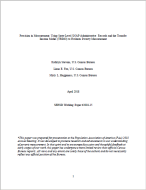Precision in Measurement: Using State-Level SNAP Administrative Records and the Transfer Income Model (TRIM3) to Evaluate Poverty Measurement
Precision in Measurement: Using State-Level SNAP Administrative Records and the Transfer Income Model (TRIM3) to Evaluate Poverty Measurement
Policy leaders today look to quality data and statistics to help inform and guide programmatic decisions. As a result, assessing the quality and validity of major household surveys in capturing accurate program participation is essential. One method for evaluating survey quality is to compare self-reported program participation in surveys to administrative records from the program itself. In this paper, we are interested in understanding two issues. First, how closely do Supplemental Nutrition Assistance Program (SNAP) participation and benefit amounts align between self-reported survey responses and other source data on program participation? Second, how does replacing household survey self-reported SNAP values with alternative source records for SNAP change poverty measurement in the Supplemental Poverty Measure (SPM)? We find that 46 percent of SNAP recipients (according to administrative records) do not report receipt in self-reported survey responses and 36 percent of SNAP recipients are not estimated to receive benefits in a microsimulation model. This results in a SPM rate that is 0.4 percentage points lower when state SNAP administrative records are used instead of survey self-reported SNAP receipt and 0.9 percentage points lower when estimates from a microsimulation model are used instead of survey self-reported SNAP receipt.




